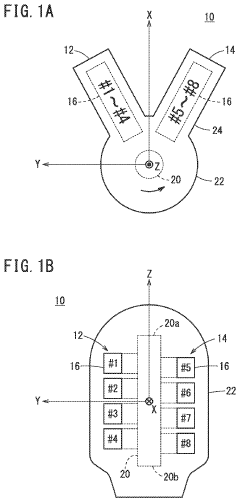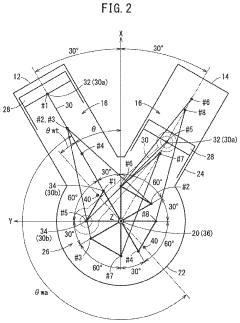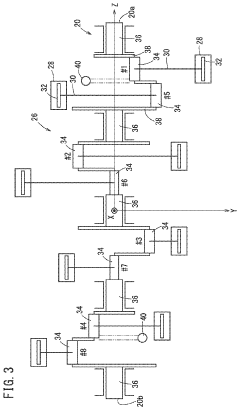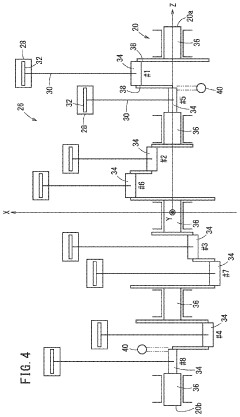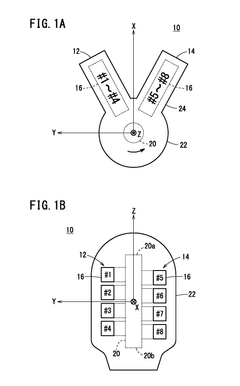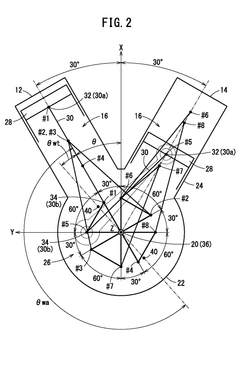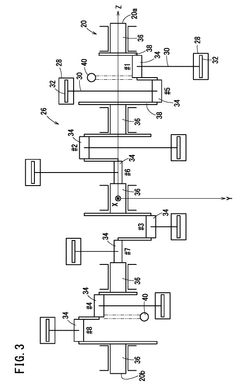How V8 Engines Help Sustain Regional Automotive Economies?
JUL 4, 20259 MIN READ
Generate Your Research Report Instantly with AI Agent
Patsnap Eureka helps you evaluate technical feasibility & market potential.
V8 Engine Evolution and Objectives
The V8 engine has been a cornerstone of automotive engineering since its inception in the early 20th century. This powerful and versatile engine configuration has played a crucial role in shaping the automotive industry and regional economies worldwide. The evolution of V8 engines has been driven by a constant pursuit of improved performance, efficiency, and environmental sustainability.
Initially developed for high-performance applications, V8 engines quickly became synonymous with American muscle cars and luxury vehicles. Their popularity stemmed from their ability to deliver substantial power and torque, making them ideal for a wide range of automotive applications. As the automotive industry evolved, so did the objectives for V8 engine development.
One of the primary goals in V8 engine evolution has been to increase power output while maintaining or reducing fuel consumption. This objective has led to significant advancements in engine design, materials, and manufacturing processes. Innovations such as variable valve timing, direct fuel injection, and cylinder deactivation have all contributed to making V8 engines more efficient and environmentally friendly.
Another key objective in V8 engine development has been to meet increasingly stringent emissions regulations. This has necessitated the integration of advanced exhaust after-treatment systems and the optimization of combustion processes. The challenge of balancing performance with environmental responsibility has driven substantial research and development efforts in the automotive industry.
The pursuit of lightweight design has also been a critical factor in V8 engine evolution. By reducing engine weight, manufacturers have been able to improve vehicle dynamics and fuel efficiency. This has led to the adoption of materials such as aluminum and even carbon fiber in engine construction, as well as the development of more compact engine designs.
In recent years, the objectives for V8 engine development have expanded to include hybridization and electrification. Many manufacturers are now integrating electric motors with V8 engines to create high-performance hybrid powertrains. This approach allows for the retention of the V8's characteristic power and sound while significantly improving fuel efficiency and reducing emissions.
The continued evolution of V8 engines has had a profound impact on regional automotive economies. Areas with a strong tradition in V8 engine production have benefited from ongoing investment in research, development, and manufacturing facilities. This has helped sustain employment in the automotive sector and related industries, while also driving innovation and technological advancement in these regions.
Initially developed for high-performance applications, V8 engines quickly became synonymous with American muscle cars and luxury vehicles. Their popularity stemmed from their ability to deliver substantial power and torque, making them ideal for a wide range of automotive applications. As the automotive industry evolved, so did the objectives for V8 engine development.
One of the primary goals in V8 engine evolution has been to increase power output while maintaining or reducing fuel consumption. This objective has led to significant advancements in engine design, materials, and manufacturing processes. Innovations such as variable valve timing, direct fuel injection, and cylinder deactivation have all contributed to making V8 engines more efficient and environmentally friendly.
Another key objective in V8 engine development has been to meet increasingly stringent emissions regulations. This has necessitated the integration of advanced exhaust after-treatment systems and the optimization of combustion processes. The challenge of balancing performance with environmental responsibility has driven substantial research and development efforts in the automotive industry.
The pursuit of lightweight design has also been a critical factor in V8 engine evolution. By reducing engine weight, manufacturers have been able to improve vehicle dynamics and fuel efficiency. This has led to the adoption of materials such as aluminum and even carbon fiber in engine construction, as well as the development of more compact engine designs.
In recent years, the objectives for V8 engine development have expanded to include hybridization and electrification. Many manufacturers are now integrating electric motors with V8 engines to create high-performance hybrid powertrains. This approach allows for the retention of the V8's characteristic power and sound while significantly improving fuel efficiency and reducing emissions.
The continued evolution of V8 engines has had a profound impact on regional automotive economies. Areas with a strong tradition in V8 engine production have benefited from ongoing investment in research, development, and manufacturing facilities. This has helped sustain employment in the automotive sector and related industries, while also driving innovation and technological advancement in these regions.
Market Demand Analysis
The market demand for V8 engines continues to play a significant role in sustaining regional automotive economies, particularly in areas with a strong tradition of automotive manufacturing. Despite the global shift towards more fuel-efficient and environmentally friendly vehicles, V8 engines maintain a dedicated consumer base, especially in the high-performance and luxury vehicle segments.
In North America, where V8 engines have long been associated with muscle cars and powerful trucks, the market demand remains robust. The cultural significance of V8-powered vehicles in this region contributes to their ongoing popularity, with many consumers valuing the distinctive sound and performance characteristics of these engines. This sustained demand helps support local economies by maintaining employment in manufacturing plants, supply chains, and related service industries.
European markets, while generally favoring smaller, more efficient engines, still exhibit a notable demand for V8 engines in premium and sports car segments. Luxury automakers continue to offer V8 options to cater to discerning customers who prioritize performance and prestige. This demand supports specialized manufacturing facilities and contributes to the high-value export market for these vehicles.
In emerging markets, particularly in the Middle East and parts of Asia, there is a growing appetite for high-performance vehicles, including those equipped with V8 engines. This trend is driven by increasing disposable incomes and a desire for status symbols among affluent consumers. The demand in these regions helps sustain production volumes and supports the global supply chain for V8 engine components.
The aftermarket and performance tuning sectors also contribute significantly to the economic impact of V8 engines. Enthusiasts and racing teams continue to invest in modifications, upgrades, and custom builds, creating a thriving ecosystem of specialized businesses and skilled labor. This niche market helps preserve technical expertise and fosters innovation in engine technology.
However, it's important to note that the market for V8 engines faces challenges from stricter emissions regulations and the push towards electrification. Manufacturers are responding by developing more efficient V8 engines, incorporating technologies such as cylinder deactivation and hybrid systems. This adaptation helps maintain the relevance of V8 engines in a changing automotive landscape and supports continued investment in related technologies and manufacturing capabilities.
The economic impact of V8 engines extends beyond direct manufacturing. These engines often serve as halo products, attracting customers to showrooms and enhancing brand prestige. This marketing effect can boost sales across a manufacturer's entire product line, indirectly supporting broader economic activities in automotive retail and services.
In North America, where V8 engines have long been associated with muscle cars and powerful trucks, the market demand remains robust. The cultural significance of V8-powered vehicles in this region contributes to their ongoing popularity, with many consumers valuing the distinctive sound and performance characteristics of these engines. This sustained demand helps support local economies by maintaining employment in manufacturing plants, supply chains, and related service industries.
European markets, while generally favoring smaller, more efficient engines, still exhibit a notable demand for V8 engines in premium and sports car segments. Luxury automakers continue to offer V8 options to cater to discerning customers who prioritize performance and prestige. This demand supports specialized manufacturing facilities and contributes to the high-value export market for these vehicles.
In emerging markets, particularly in the Middle East and parts of Asia, there is a growing appetite for high-performance vehicles, including those equipped with V8 engines. This trend is driven by increasing disposable incomes and a desire for status symbols among affluent consumers. The demand in these regions helps sustain production volumes and supports the global supply chain for V8 engine components.
The aftermarket and performance tuning sectors also contribute significantly to the economic impact of V8 engines. Enthusiasts and racing teams continue to invest in modifications, upgrades, and custom builds, creating a thriving ecosystem of specialized businesses and skilled labor. This niche market helps preserve technical expertise and fosters innovation in engine technology.
However, it's important to note that the market for V8 engines faces challenges from stricter emissions regulations and the push towards electrification. Manufacturers are responding by developing more efficient V8 engines, incorporating technologies such as cylinder deactivation and hybrid systems. This adaptation helps maintain the relevance of V8 engines in a changing automotive landscape and supports continued investment in related technologies and manufacturing capabilities.
The economic impact of V8 engines extends beyond direct manufacturing. These engines often serve as halo products, attracting customers to showrooms and enhancing brand prestige. This marketing effect can boost sales across a manufacturer's entire product line, indirectly supporting broader economic activities in automotive retail and services.
V8 Technology Status and Challenges
The current status of V8 engine technology reflects a complex interplay of technological advancements, market demands, and environmental concerns. V8 engines, known for their power and performance, continue to be a significant component in the automotive industry, particularly in luxury vehicles, sports cars, and heavy-duty trucks. However, they face substantial challenges in the contemporary automotive landscape.
One of the primary challenges for V8 engines is meeting increasingly stringent emissions regulations worldwide. As governments push for reduced carbon emissions, manufacturers are compelled to improve fuel efficiency and reduce pollutants. This has led to the development of advanced technologies such as direct injection, variable valve timing, and cylinder deactivation, which aim to enhance the efficiency of V8 engines without compromising their performance characteristics.
Another significant challenge is the shift towards electrification in the automotive industry. The rise of electric vehicles (EVs) and hybrid powertrains has put pressure on traditional internal combustion engines, including V8s. Manufacturers are investing heavily in electric and hybrid technologies, potentially diverting resources from V8 development. This trend has led to questions about the long-term viability of V8 engines in mass-market vehicles.
Despite these challenges, V8 engines continue to evolve. Recent advancements include the integration of mild hybrid systems, which can provide additional power and improve fuel economy. Some manufacturers are also exploring the use of sustainable fuels in V8 engines as a way to reduce their environmental impact while maintaining their performance characteristics.
The geographical distribution of V8 engine development and production is primarily concentrated in regions with strong automotive industries, such as North America, Germany, and Japan. These areas have historically been at the forefront of V8 engine innovation and continue to be key players in advancing the technology. However, emerging markets, particularly China, are increasingly becoming involved in V8 engine development as their automotive industries grow and mature.
In terms of technical constraints, V8 engines face challenges related to weight reduction and packaging. As vehicles become more compact and aerodynamic, fitting large V8 engines into modern car designs becomes more challenging. Engineers are working on innovative solutions, such as compact V8 designs and advanced materials, to address these issues.
The future of V8 engines in the automotive industry remains uncertain. While they continue to offer unparalleled performance and brand prestige, their role in a future dominated by electric and hybrid powertrains is unclear. The challenge for manufacturers is to balance the heritage and appeal of V8 engines with the need for more sustainable and efficient automotive technologies.
One of the primary challenges for V8 engines is meeting increasingly stringent emissions regulations worldwide. As governments push for reduced carbon emissions, manufacturers are compelled to improve fuel efficiency and reduce pollutants. This has led to the development of advanced technologies such as direct injection, variable valve timing, and cylinder deactivation, which aim to enhance the efficiency of V8 engines without compromising their performance characteristics.
Another significant challenge is the shift towards electrification in the automotive industry. The rise of electric vehicles (EVs) and hybrid powertrains has put pressure on traditional internal combustion engines, including V8s. Manufacturers are investing heavily in electric and hybrid technologies, potentially diverting resources from V8 development. This trend has led to questions about the long-term viability of V8 engines in mass-market vehicles.
Despite these challenges, V8 engines continue to evolve. Recent advancements include the integration of mild hybrid systems, which can provide additional power and improve fuel economy. Some manufacturers are also exploring the use of sustainable fuels in V8 engines as a way to reduce their environmental impact while maintaining their performance characteristics.
The geographical distribution of V8 engine development and production is primarily concentrated in regions with strong automotive industries, such as North America, Germany, and Japan. These areas have historically been at the forefront of V8 engine innovation and continue to be key players in advancing the technology. However, emerging markets, particularly China, are increasingly becoming involved in V8 engine development as their automotive industries grow and mature.
In terms of technical constraints, V8 engines face challenges related to weight reduction and packaging. As vehicles become more compact and aerodynamic, fitting large V8 engines into modern car designs becomes more challenging. Engineers are working on innovative solutions, such as compact V8 designs and advanced materials, to address these issues.
The future of V8 engines in the automotive industry remains uncertain. While they continue to offer unparalleled performance and brand prestige, their role in a future dominated by electric and hybrid powertrains is unclear. The challenge for manufacturers is to balance the heritage and appeal of V8 engines with the need for more sustainable and efficient automotive technologies.
Current V8 Engine Solutions
01 V8 Engine Design and Configuration
V8 engines are designed with eight cylinders arranged in two banks of four, forming a V-shape. This configuration allows for a compact design, improved balance, and higher power output compared to inline engines. Various aspects of V8 engine design, including cylinder arrangement, crankshaft configuration, and valve timing, are optimized for performance and efficiency.- V8 Engine Design and Configuration: V8 engines are designed with eight cylinders arranged in two banks of four, forming a V-shape. This configuration allows for a compact design while providing high power output. Various aspects of V8 engine design, including cylinder arrangement, crankshaft configuration, and valve timing, are optimized for performance and efficiency.
- Fuel Injection Systems for V8 Engines: Advanced fuel injection systems are developed for V8 engines to improve fuel efficiency and performance. These systems may include direct injection, multi-port injection, or a combination of both. Innovations in fuel injector design and control strategies aim to optimize fuel delivery and combustion processes in V8 engines.
- V8 Engine Performance Enhancement: Various technologies and methods are employed to enhance the performance of V8 engines. These may include turbocharging, supercharging, variable valve timing, and advanced engine management systems. Innovations focus on increasing power output, improving torque characteristics, and enhancing overall engine efficiency.
- Emissions Control in V8 Engines: Developing effective emissions control systems for V8 engines is crucial to meet stringent environmental regulations. Technologies such as exhaust gas recirculation (EGR), catalytic converters, and particulate filters are optimized for V8 engines to reduce harmful emissions while maintaining performance.
- V8 Engine Cooling and Lubrication: Efficient cooling and lubrication systems are essential for V8 engines due to their high power output and thermal loads. Innovations in coolant flow design, oil circulation, and thermal management aim to improve engine durability, reduce friction, and optimize overall performance in various operating conditions.
02 Fuel Injection Systems for V8 Engines
Advanced fuel injection systems are crucial for V8 engine performance and efficiency. These systems may include direct injection, multi-point injection, or a combination of both. Innovations in fuel injection technology focus on improving fuel atomization, precise fuel delivery, and optimizing combustion for better power output and reduced emissions.Expand Specific Solutions03 V8 Engine Cooling and Lubrication
Effective cooling and lubrication systems are essential for V8 engine reliability and longevity. Innovations in this area include advanced coolant circulation methods, oil cooling techniques, and improved lubricant formulations. These systems help manage the high heat output of V8 engines and ensure proper lubrication of critical components under various operating conditions.Expand Specific Solutions04 V8 Engine Performance Enhancement
Various technologies and methods are employed to enhance V8 engine performance. These may include turbocharging, supercharging, variable valve timing, and advanced engine management systems. Innovations in these areas aim to increase power output, improve fuel efficiency, and optimize engine response across different operating ranges.Expand Specific Solutions05 V8 Engine Emissions Control
Emissions control is a critical aspect of modern V8 engine design. Technologies such as exhaust gas recirculation (EGR), catalytic converters, and particulate filters are employed to reduce harmful emissions. Innovations in this field focus on meeting increasingly stringent emissions regulations while maintaining engine performance and efficiency.Expand Specific Solutions
Key V8 Engine Manufacturers
The V8 engine market is in a mature stage, with established players dominating the landscape. The global V8 engine market size is estimated to be in the billions of dollars, driven by demand in high-performance vehicles and luxury segments. Technologically, V8 engines are well-developed, but innovations continue in areas like fuel efficiency and emissions reduction. Key players like GM, Ford, and Toyota lead in V8 engine technology, with significant R&D investments. European manufacturers such as BMW and Volvo also maintain strong positions. While traditional automotive powerhouses dominate, emerging companies and research institutions are exploring advancements in V8 technology, particularly in areas of sustainability and performance optimization.
GM Global Technology Operations LLC
Technical Solution: GM's V8 engine technology, particularly the Small Block V8, has been a cornerstone of regional automotive economies. The company has invested heavily in advanced manufacturing facilities for V8 production, creating jobs and fostering local supply chains. GM's V8 engines feature technologies like Dynamic Fuel Management and Active Fuel Management, which improve fuel efficiency without sacrificing power[1]. These innovations have helped maintain demand for V8-powered vehicles, supporting regional economies dependent on automotive manufacturing. GM has also adapted its V8 technology for various applications, from high-performance sports cars to heavy-duty trucks, ensuring a diverse market presence[2].
Strengths: Wide range of applications, fuel efficiency innovations, established manufacturing infrastructure. Weaknesses: Increasing pressure from emissions regulations, shift towards electrification potentially reducing long-term demand.
Ford Global Technologies LLC
Technical Solution: Ford's V8 engine technology, exemplified by the Coyote and Godzilla engines, plays a crucial role in sustaining regional automotive economies. The company has invested in modernizing its V8 production facilities, creating high-skilled jobs and supporting local suppliers. Ford's V8 engines incorporate advanced technologies such as dual fuel injection systems and variable camshaft timing, enhancing performance and efficiency[3]. The company has also developed modular V8 architectures, allowing for cost-effective production across different vehicle platforms. Ford's commitment to V8 technology in its F-Series trucks, which are consistently best-sellers, has a significant impact on regional economies, particularly in areas with strong automotive manufacturing presence[4].
Strengths: Strong presence in high-volume truck market, advanced efficiency technologies, modular design approach. Weaknesses: Increasing regulatory pressure on emissions, potential long-term shift away from large displacement engines.
V8 Engine Core Innovations
V8 engine
PatentActiveUS20230109196A1
Innovation
- The V8 engine configuration features crank pins arranged at 90° intervals on one bank and offset by 60° on the other bank, allowing for cancellation of primary inertia couples without additional specialized components by optimizing the arrangement of crank pins and connecting rods.
V8 engine
PatentWO2021171405A1
Innovation
- The engine is configured with a 60° bank angle, where crank pins on one bank are arranged at 90° intervals and offset by 60° from the other bank, allowing for cancellation of the primary inertia couple without additional special parts, and the ignition timing is set to achieve balanced explosions similar to conventional V8 engines.
Economic Impact of V8 Production
The production of V8 engines plays a significant role in sustaining regional automotive economies, contributing to job creation, economic growth, and technological advancement. These powerful engines, known for their performance and durability, have become a cornerstone of many automotive manufacturing hubs around the world.
In regions where V8 engine production is concentrated, the economic impact is substantial. The manufacturing process requires a skilled workforce, including engineers, technicians, and assembly line workers. This demand for specialized labor creates high-paying jobs and fosters the development of a robust local talent pool. Furthermore, the presence of V8 engine production facilities often attracts related industries, such as parts suppliers and aftermarket manufacturers, creating a cluster effect that amplifies economic benefits.
The economic ripple effect extends beyond direct employment in engine production. Supporting industries, including logistics, maintenance services, and research and development facilities, also experience growth. This diversification of the local economy helps to insulate regions from economic downturns in any single sector, providing greater stability and resilience.
V8 engine production also drives innovation and technological advancement. The continuous pursuit of improved performance, fuel efficiency, and emissions reduction in V8 engines leads to investments in research and development. This not only keeps the regional workforce at the forefront of automotive technology but also can result in spillover effects, benefiting other industries through the transfer of knowledge and technologies.
Moreover, regions known for V8 engine production often develop a strong automotive culture and heritage. This can translate into tourism opportunities, with enthusiasts visiting manufacturing facilities, museums, and automotive events. Such activities further contribute to the local economy through hospitality and retail sectors.
The export potential of V8 engines also plays a crucial role in regional economic sustainability. High-performance engines are often in demand globally, providing a steady stream of revenue and helping to balance trade deficits. This international demand can lead to increased production volumes, economies of scale, and improved competitiveness for the region's automotive sector.
However, it's important to note that the economic impact of V8 production is not without challenges. Environmental concerns and shifting consumer preferences towards more fuel-efficient vehicles may influence future demand. Regions heavily dependent on V8 production must therefore balance their economic interests with adaptability to changing market conditions and regulatory landscapes.
In regions where V8 engine production is concentrated, the economic impact is substantial. The manufacturing process requires a skilled workforce, including engineers, technicians, and assembly line workers. This demand for specialized labor creates high-paying jobs and fosters the development of a robust local talent pool. Furthermore, the presence of V8 engine production facilities often attracts related industries, such as parts suppliers and aftermarket manufacturers, creating a cluster effect that amplifies economic benefits.
The economic ripple effect extends beyond direct employment in engine production. Supporting industries, including logistics, maintenance services, and research and development facilities, also experience growth. This diversification of the local economy helps to insulate regions from economic downturns in any single sector, providing greater stability and resilience.
V8 engine production also drives innovation and technological advancement. The continuous pursuit of improved performance, fuel efficiency, and emissions reduction in V8 engines leads to investments in research and development. This not only keeps the regional workforce at the forefront of automotive technology but also can result in spillover effects, benefiting other industries through the transfer of knowledge and technologies.
Moreover, regions known for V8 engine production often develop a strong automotive culture and heritage. This can translate into tourism opportunities, with enthusiasts visiting manufacturing facilities, museums, and automotive events. Such activities further contribute to the local economy through hospitality and retail sectors.
The export potential of V8 engines also plays a crucial role in regional economic sustainability. High-performance engines are often in demand globally, providing a steady stream of revenue and helping to balance trade deficits. This international demand can lead to increased production volumes, economies of scale, and improved competitiveness for the region's automotive sector.
However, it's important to note that the economic impact of V8 production is not without challenges. Environmental concerns and shifting consumer preferences towards more fuel-efficient vehicles may influence future demand. Regions heavily dependent on V8 production must therefore balance their economic interests with adaptability to changing market conditions and regulatory landscapes.
Environmental Regulations and V8 Engines
Environmental regulations have significantly impacted the automotive industry, particularly concerning V8 engines. These regulations aim to reduce emissions and improve fuel efficiency, posing challenges for manufacturers of high-performance vehicles. The implementation of stringent emission standards, such as Euro 6 in Europe and Tier 3 in the United States, has forced automakers to adapt their V8 engine designs to meet these requirements.
One of the primary strategies employed by manufacturers is the integration of advanced technologies into V8 engines. This includes the adoption of direct fuel injection, variable valve timing, and cylinder deactivation systems. These innovations allow V8 engines to operate more efficiently, reducing fuel consumption and emissions while maintaining their characteristic power output.
Turbocharging and supercharging have become increasingly common in V8 engines, enabling manufacturers to downsize engine displacement while maintaining or even increasing power output. This approach helps meet emission standards without sacrificing performance, a crucial factor for maintaining consumer appeal in regional automotive markets.
The development of hybrid and mild-hybrid systems for V8-powered vehicles has also gained traction. By incorporating electric motors and battery packs, these systems can provide additional power and improve fuel efficiency, helping manufacturers meet regulatory requirements while preserving the V8 engine's role in their product lineups.
Despite these advancements, some regions have implemented or proposed bans on the sale of new internal combustion engine vehicles, including those with V8 engines. This has led to increased investment in alternative powertrain technologies, such as all-electric and hydrogen fuel cell systems, potentially threatening the long-term viability of V8 engines in certain markets.
However, the cultural significance and economic impact of V8 engines in many regions have prompted some governments to consider exemptions or extended timelines for high-performance vehicles. This approach aims to balance environmental concerns with the economic benefits provided by the automotive industry, particularly in areas where V8 engine production plays a significant role in the local economy.
The ongoing challenge for manufacturers and regional economies reliant on V8 engine production is to continue innovating and adapting to evolving environmental regulations. This may involve further refinements to engine technology, increased electrification, or the development of synthetic fuels that could potentially allow V8 engines to operate with significantly reduced emissions.
One of the primary strategies employed by manufacturers is the integration of advanced technologies into V8 engines. This includes the adoption of direct fuel injection, variable valve timing, and cylinder deactivation systems. These innovations allow V8 engines to operate more efficiently, reducing fuel consumption and emissions while maintaining their characteristic power output.
Turbocharging and supercharging have become increasingly common in V8 engines, enabling manufacturers to downsize engine displacement while maintaining or even increasing power output. This approach helps meet emission standards without sacrificing performance, a crucial factor for maintaining consumer appeal in regional automotive markets.
The development of hybrid and mild-hybrid systems for V8-powered vehicles has also gained traction. By incorporating electric motors and battery packs, these systems can provide additional power and improve fuel efficiency, helping manufacturers meet regulatory requirements while preserving the V8 engine's role in their product lineups.
Despite these advancements, some regions have implemented or proposed bans on the sale of new internal combustion engine vehicles, including those with V8 engines. This has led to increased investment in alternative powertrain technologies, such as all-electric and hydrogen fuel cell systems, potentially threatening the long-term viability of V8 engines in certain markets.
However, the cultural significance and economic impact of V8 engines in many regions have prompted some governments to consider exemptions or extended timelines for high-performance vehicles. This approach aims to balance environmental concerns with the economic benefits provided by the automotive industry, particularly in areas where V8 engine production plays a significant role in the local economy.
The ongoing challenge for manufacturers and regional economies reliant on V8 engine production is to continue innovating and adapting to evolving environmental regulations. This may involve further refinements to engine technology, increased electrification, or the development of synthetic fuels that could potentially allow V8 engines to operate with significantly reduced emissions.
Unlock deeper insights with Patsnap Eureka Quick Research — get a full tech report to explore trends and direct your research. Try now!
Generate Your Research Report Instantly with AI Agent
Supercharge your innovation with Patsnap Eureka AI Agent Platform!
